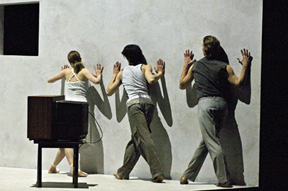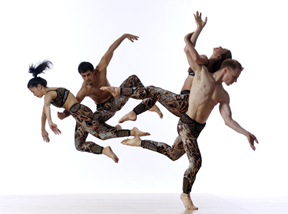Sweet Edward
Matthew Bourne's "Edward Scissorhands"
by Lisa Rinehart
Don't go to Matthew Bourne's "Edward Scissorhands" looking for depth, or for a delicate Burtonesque fable. Go for a good time. With an eye for caricature, Bourne has blunted the edginess of Burton's deliciously odd movie and whipped up a snappy cartoon of suburban agita that's smart and entertaining. The downside of Bourne's talent as a showman is that, while he nails the high octane blaze of suburban self-satisfaction, Edward (endearingly played by Sam Archer) comes off as a poster child for cute strangeness. Even with shears flashing, Bourne's Edward is unthreatening, almost cuddly, and Burton's fragile artist — the oddity able to reveal people to themselves — is reduced to the dorky guy simply trying to fit in. READ MORE
Noh-Now in New York
Takeshi Kawamura’s Aoi/Komachi
by Tom Phillips
 The drama in Japan’s classic Noh theater comes in “the collapse of time, with elements of the past overtaking the present.” That’s a quote from program notes by Yoko Shioya, artistic director of the Japan Society. But in the opening production of her series “Noh-Now!” the present is also taking over the past, with a pair of 14th century Noh plays re-imagined by director Takeshi Kawamura in contemporary settings — a hair salon and a movie theater. READ MORE
The drama in Japan’s classic Noh theater comes in “the collapse of time, with elements of the past overtaking the present.” That’s a quote from program notes by Yoko Shioya, artistic director of the Japan Society. But in the opening production of her series “Noh-Now!” the present is also taking over the past, with a pair of 14th century Noh plays re-imagined by director Takeshi Kawamura in contemporary settings — a hair salon and a movie theater. READ MORE
Letter from Copenhagen
"American Mixture" program at the Royal Danish Ballet
by Eva Kistrup
 I do not think that Frank Andersen dislikes modern ballet. He has commissioned several new modern ballets, he has served on the board of the leading alternative modern Danish company, and he has been active in setting up competitions and prizes for new choreographers. His visions definitely go beyond his happy Bournonville boy image.
I do not think that Frank Andersen dislikes modern ballet. He has commissioned several new modern ballets, he has served on the board of the leading alternative modern Danish company, and he has been active in setting up competitions and prizes for new choreographers. His visions definitely go beyond his happy Bournonville boy image.
But liking modern ballet and understanding the artistic process on how to create a modern work of quality eludes him as a ballet master. And that is the main reason why so many attempts to get original modern choreography into the RDB repertoire fail.
This week's programme, American Mixture, is a prime example of how not understanding and respecting the choreographers' integrity leads to second-rate works and programmes that are not really interesting for either audience or dancers. READ MORE
Taylor Company Ends Season
by Leigh Witchel
 Paul Taylor’s company closed its New York season with a substantial triple bill. “Dante Variations,” the most recent work (2004), led off and was the darkest in mood. Its equivocal metaphysics recalls “Fiends Angelical,” made three years previous to it. Annmaria Mazzini enters to dance a solo with her wrists bound by a white cloth; a similar cloth is stuck persistently to Robert Kleinendorst’s foot. Michael Trusnovec is at the apex of a pyramid of souls to open; he and Lisa Viola dance an extended pas de deux that turns into a game of blind man’s buff. READ MORE
Paul Taylor’s company closed its New York season with a substantial triple bill. “Dante Variations,” the most recent work (2004), led off and was the darkest in mood. Its equivocal metaphysics recalls “Fiends Angelical,” made three years previous to it. Annmaria Mazzini enters to dance a solo with her wrists bound by a white cloth; a similar cloth is stuck persistently to Robert Kleinendorst’s foot. Michael Trusnovec is at the apex of a pyramid of souls to open; he and Lisa Viola dance an extended pas de deux that turns into a game of blind man’s buff. READ MORE